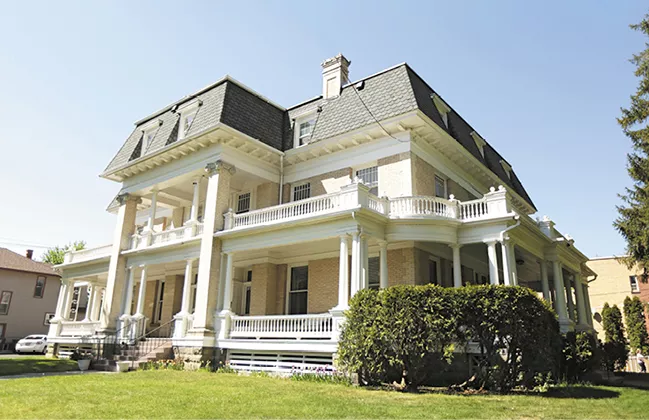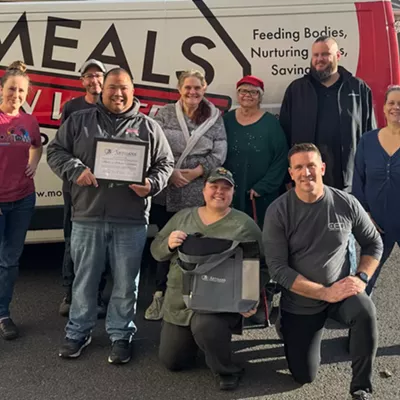Toys are stacked on the front porch of the Isabella House, but the kids are nowhere to be seen. Inside the front door and behind a red, velvety curtain in the imposing 113-year-old house on the edge of Coeur d’Alene Park in Browne’s Addition, their playroom is also abandoned, smelling faintly of cleaning product.
“The kids are at the park,” says Art Jacobs, who runs the house. “The women are meeting.”
Jacobs is leading a tour of the inpatient facility, which serves chemically dependent “pregnant or post-partum women.” There’s the TV room with seats for a dozen or more people, the dining area for twice as many and the kitchen, where a woman is lining up frozen burger patties on a baking sheet. Behind a closed door, the women who live here are talking.
In the stairwell, a whiteboard gives the only real clue as to why all these women live together. It has the names of the residents gridded out below strange headers like “Blackout” and “Phase One.” There’s one ominous category: “AWOL.”
The women who live here have been nurses, teachers, homeless. They’re young and older. The one thing that connects them is addiction, be it meth, prescription drugs or alcohol. And now, for reasons usually beyond their control, they stay here for up to six months to get clean, share in the housekeeping duties and babysitting, and help guide each other to a sobriety that sticks.
“The longer they stay, the better their chances of recovery,” says Jacobs. “I tell my patients every day is a critical day, an important day.”
The Isabella House, run by New Horizon Care Centers, is just one of nine residential treatment agencies in Spokane that has a contract to do business with the state. It’s also one of dozens of programs and services aimed to help people kick whatever chemical they’ve staked their lives upon.
The state’s Department of Social and Health Services alone certifies 47 chemical dependency services in Spokane County. The county’s Community Services, Housing, and Community Development Department certifies 24 providers, though there is some overlap.
It’s a system designed to help people stop using drugs, a bulwark against the corruption of the basic underpinnings of society. But it’s a complicated and opaque system. And conquering addiction — both physically and mentally — is an enormous task. It’s no wonder some say the system doesn’t do enough, or doesn’t work at all.
“Overall, there is definitely a need for additional funding for substance abuse,” says Christine Barada, director of the county’s community services department. “We work with a large number of providers in the community. Those providers will tell you they struggle to provide the services.”
Asked if there are people out there who can’t get help simply because there’s not enough money available to fund the programs at an adequate level, Barada doesn’t have to think long about it.
“There are a lot more,” she says. “Specifically, lower income people.”
Historically, the state doled out its funding based on population. In Spokane County’s case, this amounted to the county receiving just 8 percent of funding allocated for chemical dependency in the state.
“Moving forward into our new contract year, we have a new formula that will be based on the number of people who are at 200 percent or less of the federal poverty line,” says Charisse Pope, the county’s drug and alcohol coordinator. “These folks need more help. They are the ones who have lost their homes or are in jeopardy of losing them.”
Simply put, this is a good thing. But there’s nothing simple about the way treating drug abuse is funded.
“The challenge is it comes in different streams,” says Pope. “Each stream is targeted to different individuals with different rules. That’s a real challenge. Sometimes the funding is lopsided.”
There’s the money dedicated to methadone or suboxone. There’s adult outpatient and youth outpatient, detoxification, sobering, and child care for individuals in treatment and people who fall under the involuntary treatment act.
The county also receives Medicaid through the state, which can be used for dependency programs. It gets grants and aid for people who fall under the federal poverty level. Money comes in for parents who are in jeopardy of losing children if they don’t get treatment. There’s funding for people who get in trouble with the law.
That’s not even the end of it. The state itself takes care of a slew of other programs without the county’s help, including inpatient facilities like the Isabella House.
As Jacobs enters just about every room at Isabella House with barely a knock, it’s clear that the women signed over any right to privacy when they entered the door.
“They don’t have it,” he says. “We need to be able to go into their rooms at all times.”
When the women want to leave the house, they have to make a request. They have to say where exactly they’re going, when they’re leaving and when they’ll be back. They have to call every hour to check in. They gave their life to drugs; now they’ve given their lives to Isabella.
The difference is, the 23 women and their 18 kids are doing it together. Some of them are relearning what it’s like to lead a drug-free life as an adult. Others are learning it for the first time.
Those at Isabella House are, in a sense, lucky. They are receiving treatment. According to the National Institutes of Health, 23.2 million people in the United States needed treatment for a drug or alcohol problem in 2007. Only 2.4 million got it. In other words, nine of 10 people who needed help didn’t get it.
For nearly everyone in treatment, conquering substance abuse is an uphill climb.
Studies have shown that drug abuse has a long life, in many cases lasting more than a decade from first use to last. One study of opiate users showed that over the course of 12 months, more than two-thirds relapsed to daily use.
In all likelihood, staying clean will take more than one episode of treatment.
Spokane Valley’s Laurie Taggart has watched both of her sons struggle, again and again, to overcome addiction. Her oldest son’s troubles began when he got a DUI at 17. He sought treatment at Lakeside Recovery Center, but the teen was out of place among 50-year-old alcoholics. A minor-in-possession charge in Cheney came when he was 19. And after failing a third drug test stemming from that charge, a judge ordered his arrest, and he was sent to Geiger Corrections Center in Airway Heights.
“He told me he saw worse stuff there than ever before,” Taggart says. “The first time he saw heroin was there.” Now 23, he’s in jail in Wheatland, Wyoming. Taggart isn’t sure for how long.
Her youngest son is now 21 and still lives at home, pouring cement by day to pay off the $5,000 in court fines he’s accrued getting in trouble as a teen. Problems, she says, really began when he was devastated after getting cut from the high school baseball team. He started drinking and smoking pot. Then he tried to sell a breath mint as Ecstasy to a classmate. He was arrested and charged with a felony, says Taggart. His life tumbled after that. He was enrolled in Daybreak Youth Services’ outpatient program. Then he was sent to 40 days in the wilderness with the SUWS Wilderness program in Idaho, an accredited intervention program for kids.
He came back “looking great,” says Taggart, but it didn’t stick. He’s finally broken free from some of his demons, but “he’s still struggling,” says Taggart, adding hopefully, “He’s not drinking.”
She keeps both her boys on her health insurance, just in case they want to enter a program, but she looks skeptically at the system she’s been involved with so far. She doesn’t blame anyone other than her kids — and herself — and she doesn’t view them as unwilling victims. She just wishes something had worked.
“Kids can’t do a 12-step program. They don’t get it,” she says.
With offenses racking up thousands of dollars in fines, Taggart says it becomes harder and harder for people to get out of the system. “Once they get into the court system, that’s what’s wrong with it, you can’t get out.”
Sandra Altshuler doesn’t blame Taggart for being frustrated. Kicking a habit is a tough task, with substance abuse treatment programs nationwide succeeding with just 40 percent of their clients.
“I look at research all the time,” says Altshuler, the coordinator of Behavioral Health Adult Felony Therapeutic Drug Court, which is part of the Spokane County Superior Courts. “We really can’t predict who will succeed and graduate. We can’t predict it. The good news of that, in my opinion, is we don’t exclude people.”
Altshuler says the drug court she runs has a 70 percent success rate, something she lays squarely on the shoulders on the coupling of addiction treatment with the court system, a concept borne out by the latest research.
“We have the threat of the law behind us,” she says. “I hate to be harsh about it, but that’s the truth of it. … The judge doesn’t sit there and yell at them, but it’s a full-blown courtroom hearing.”
It’s also a full year of participation by the people who sign up, ending with at least four months of sobriety, checked by random drug tests. Throughout the year, the court’s participants become more and more involved in what Altshuler calls the “recovery community.”
“By the time they graduate, they’re committed citizens rather than a drain on society, so to speak,” she says.
The added bonus for the graduates is simple and real: Their charges are dropped. After all, this is a court, and the people who wound up here were in trouble with the law. Altshuler notes the court doesn’t accept violent or sex offenders.
Nationwide, addicts have about an 80 percent recidivism rate, meaning the vast majority break the law after being released from incarceration. Drug courts across the country average about 35 percent.
“Ours has a 20 to 25 percent recidivism rate,” she says. “Even those who have left the program [prematurely] … have a 45 percent recidivism rate. So at least we helped them in some way.”
For some, at least, “it is possible,” says Altshuler. “It is absolutely possible” to get out of the system.
A Painful Process
Kicking drugs is complicated in part because of the painful process of withdrawal. The New Vision program at Providence Holy Family Hospital focuses on helping people through those initial tough days without chemicals. But while desperate family members may want to drop off an addict, that's not part of the plan.
"We are a self-referred service. So we don't do any involuntary treatment. The patient has to be the one to call us," says Jina Doggett, service coordinator at New Vision. "Intake takes about 30 minutes over the phone. We're asking them demographic info, use history, medication that they're on, anything the doctor would need to know, insurance info."
When the patient shows up, they have to show signs of withdrawal. Then it's a three-day stay, on average, with their own private room and bathroom. "We don't want them mingling with other patients. It's more of a private process," says Doggett. "There's nothing social about ours. There's no behavioral health program. It's strictly a medical-based service."
As a "medical stabilization service," there's 24-hour supervision by a medical professional and a doctor on hand to dispense medication.
The goal: to get patients medically stabilized so they won't be distracted when they're at inpatient or outpatient services following their stay.
About 30 to 40 patients receive care each month, at an average cost of $5,325 for a three-day stay.
"We are the only medical detox on this side of the Cascades. We don't have a charity bed — yet," says Doggett. "But we do accept Medicaid. We accept any insurance, state or private. And we do accept cash."




















